Wildlife
In the Town of LaSalle, being environmentally cautious is key to preserving the natural beauty and ecological balance of the area. LaSalle is home to several environmentally sensitive regions, such as the waterfront along the Detroit River, the wetlands, and the many forests and green spaces that provide vital habitats for wildlife.
Residents and visitors must actively engage in practices that help protect these vital ecosystems. Reducing pollution, conserving water, promoting biodiversity, and respecting natural habitats are essential steps in ensuring that LaSalle’s environment remains healthy for generations to come. Whether it’s through supporting local conservation initiatives, reducing waste, or avoiding harmful chemicals, each action plays a significant role in safeguarding the town's sensitive areas.
The importance of protecting LaSalle’s natural environment cannot be overstated. As a community, we must take collective responsibility for maintaining the ecological integrity of our parks, wetlands, and the riverfront, ensuring that LaSalle remains a vibrant and sustainable place for both people and wildlife.
Environmentally sensitive areas (ESAs)
Are places that are particularly vulnerable to harm or damage due to their unique natural characteristics. These areas play a crucial role in supporting wildlife, maintaining water quality, and protecting biodiversity. They can include things like wetlands, forests, riverbanks, and coastal areas, as well as habitats for endangered species.
Here's why they are so important:
-
Biodiversity Hotspots: ESAs are home to many types of plants, animals, and insects, some of which might only live in these specific environments. Protecting these areas helps keep our ecosystems healthy.
-
Water Protection: Areas like wetlands or riverbanks help filter and clean water, preventing pollution from spreading to other areas. They also act as natural buffers, reducing the risk of floods by absorbing excess water.
-
Climate Change Mitigation: Forests and wetlands help absorb carbon dioxide from the atmosphere, which can help slow down climate change. They play a big role in balancing our planet's climate.
Because they are sensitive, even small changes can have a big impact. Activities like construction, pollution, or invasive species can harm these areas, which is why it's important for governments and communities to protect them.
Species at Risk (SARs)
This section refers to animals, plants, or insects that are in danger of disappearing from the planet. These species are at risk for a variety of reasons, such as loss of their natural habitats, climate change, pollution, hunting, or the introduction of invasive species that compete with them for food or space.
There are several levels of risk, ranging from species that are just starting to show signs of trouble to those that are on the verge of going extinct. Here are some common terms used to describe them:
-
Endangered: These species are at a very high risk of disappearing completely if something isn’t done to protect them. For example, there might be only a few hundred or even just a few dozen left in the wild.
-
Threatened: These species are at risk of becoming endangered in the near future. They may still have healthy populations, but certain factors are making their survival more difficult.
-
Special Concern: These species aren’t in immediate danger, but their numbers are decreasing, or their habitats are being affected, and they could become more at risk if conditions don’t improve.
Every species plays a role in the ecosystem, whether it’s pollinating plants, controlling pests, or providing food for other animals. When species at risk disappear, it can disrupt the balance of nature and have effects on the environment and even human communities. Protecting these species helps maintain healthy ecosystems and the benefits they provide.
Species listed within the ecosystem of LaSalle are;
- Eastern Massasauga Snakes
- Butternut Trees
- Eastern Fox Snakes
Eastern Massasaugas in LaSalle
A small population of Eastern Massasauga Rattlesnakes remain in some of LaSalle's parks and natural areas. Massasaugas have called LaSalle home since long before European settlement of the region. Having benefitted from a much wider range in historic times, the species' habitat is now confined to a few hundred hectares of parkland and other natural areas in West Windsor and LaSalle. Unfortunately, the Eastern Massasauga (Carolinian population) is now listed as an endangered species due to loss of habitat and intentional killing by people. Recent estimates suggest as few as 15 Eastern Massasaugas remain in the local area, and they need your help to survive locally. This shy 'pygmy' rattler, although very seldom seen in the wild, is still widely encountered as the mascot of LaSalle's local hockey team, the LaSalle Vipers!
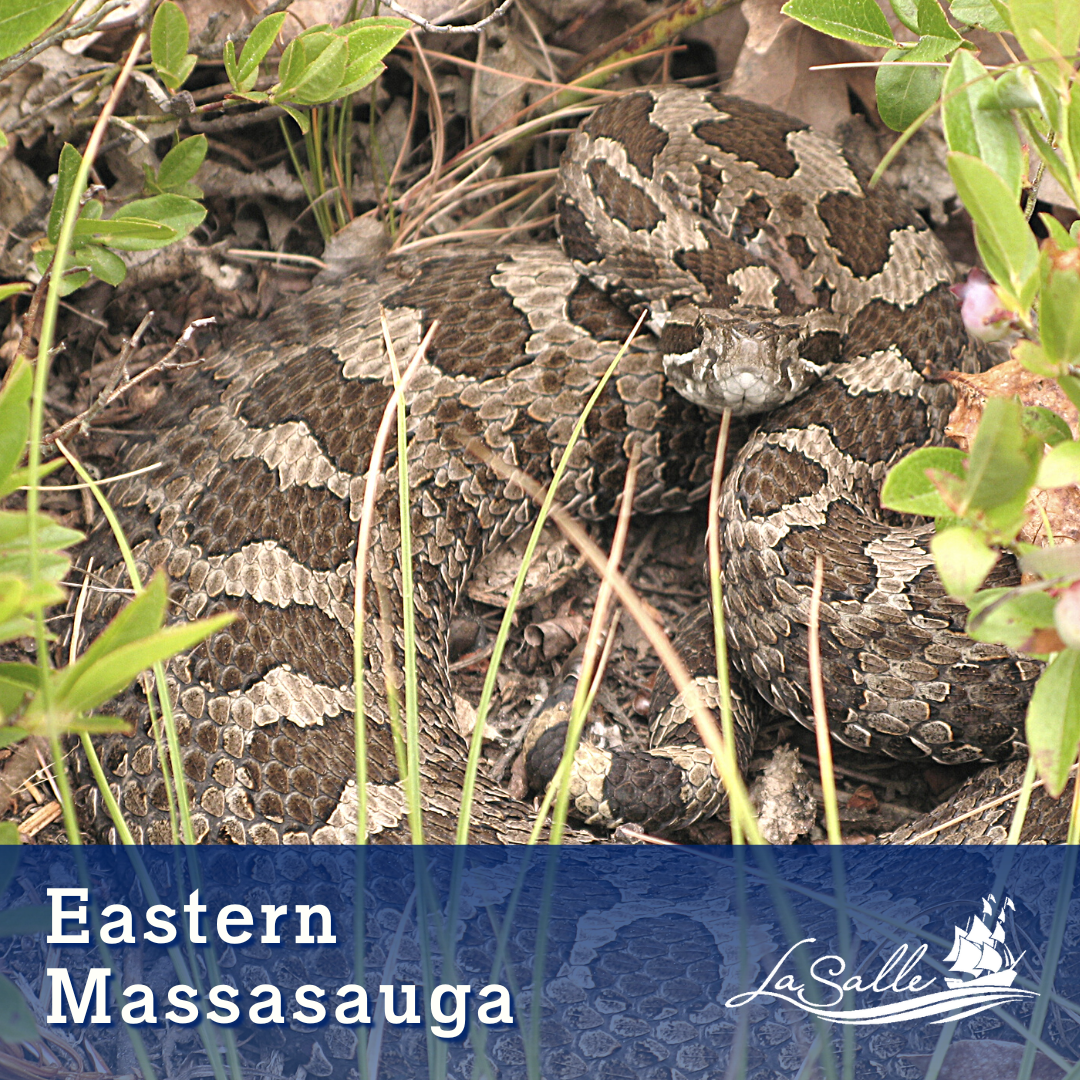
The Massasauga is the only venomous snake in Ontario; however, snakebites are extremely rare and can be easily avoided by leaving these shy, non-aggressive, snakes alone; or, seeking professional help in special situations. Here are some tips to avoid snakebites to your pets and loved ones:
- Keep dogs on leash when walking or hiking in LaSalle's natural areas and stay on designated trails.
- Wear long pants and hiking boots when hiking off trail.
- If you encounter a Massasauga while walking on or off trail, please leave it alone and observe it from a safe distance, it will eventually move on.
- If you encounter a Massasauga on your property and you are concerned for the safety of yourself, others, or the snake, please contact the Ojibway Nature Centre (519-966-5852, open 10am-5pm daily), or, after hours contact the LaSalle Police (519-969-5210). Do not attempt to capture and move a rattlesnake without professional help as this will increase your risk of snakebite and the risk of harm to the snake.
- If you see a Massasauga, please don't kill it! Not only is it wrong to kill a member of an endangered species, it is illegal, and you are putting yourself at greater risk of snakebite. Please remember that Massasaugas are protected by law under Ontario's Endangered Species Act. This means that it is illegal to kill, harm or capture a Massasauga or damage its habitat.
You can help save this endangered species by being a good steward:
- Report Massasauga sightings, preferably with a photo, to the Ojibway Nature Centre (519-966-5852, ojibway@citywindsor.ca) to help scientists monitor the population,
- Report any suspected illegal activity resulting in harm to an endangered species or its habitat to CRIMESTOPPERS at 1-800-222-TIPS
- Encourage more positive attitudes toward Massasaugas among your friends and neighbours.
In the rare event of a rattlesnake bite, seek emergency medical care immediately! Modern antivenin is the most effective treatment for snakebite and is available locally (Windsor Regional Hospital - Ouellette Campus, 1030 Ouellette Ave., Windsor, ON). If the bite occurred to a pet, seek immediate veterinary care (antivenin is generally not used on pets). There is no need to kill the snake for identification purposes; however, a photo would help to rule out the non-venomous Eastern Fox snake.
Eastern Foxsnake
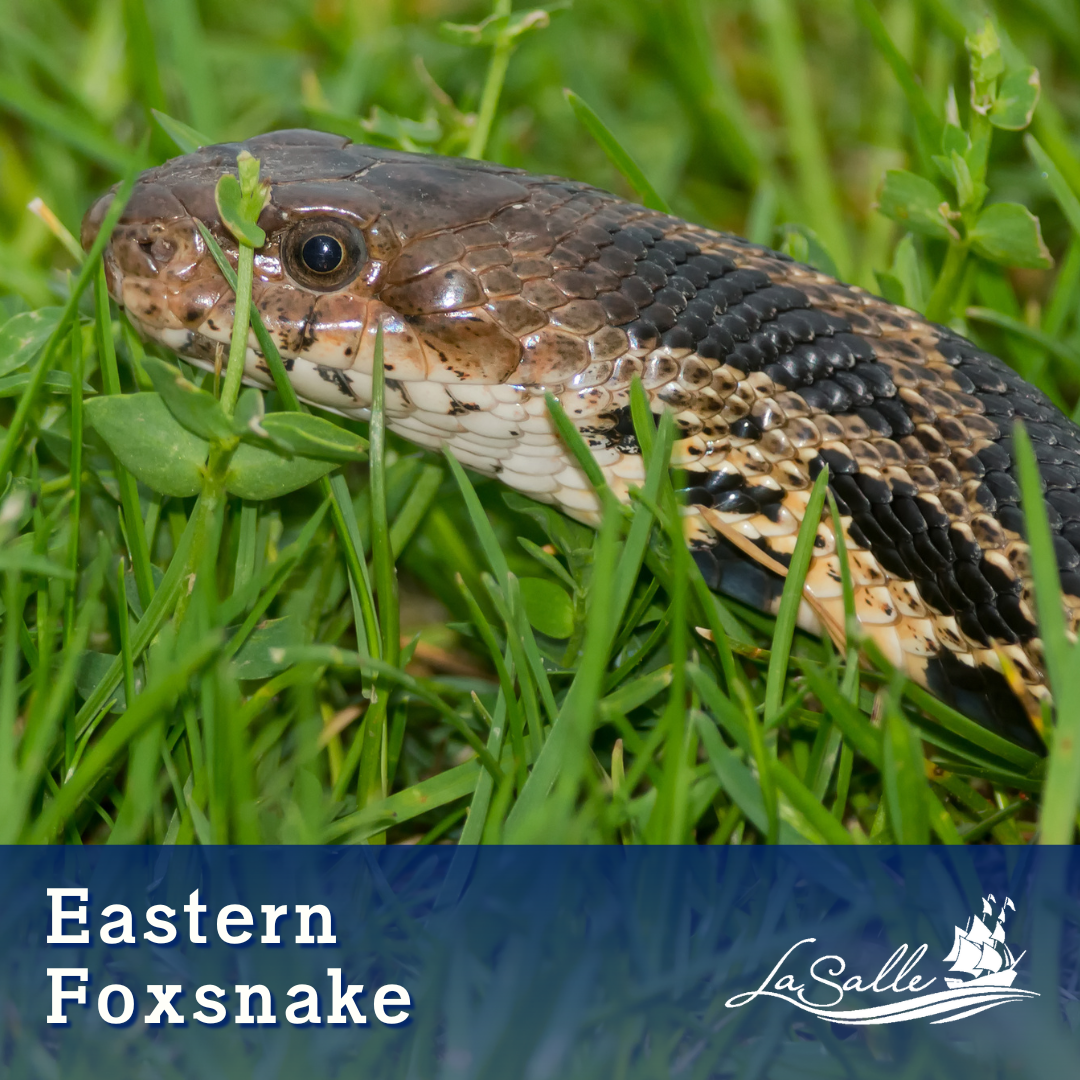
The Eastern Foxsnake, a species that is often mistaken for a rattlesnake, can reach lengths up to twice as long as a Massasauga (170cm [67 in]), has a more slender body, and a pointed tail without a rattle (Figure 2). In an attempt to mimic a rattlesnake when they feel threatened, Foxsnakes sometimes vibrate their tails against grass and leaf litter to create a buzzing sound but they do not have an actual segmented rattle.
In contrast to the Massasauga, Foxsnakes are yellow to brown in colour with square-shaped dark blotches on the back and a distinctive checkered pattern on the belly (Massasaugas have a black belly).
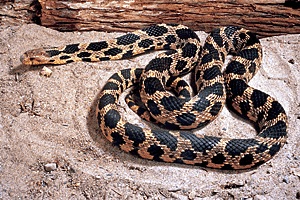
The Eastern Foxsnake is an endangered species (Carolinian population) due to habitat loss, being hit by vehicles, and deliberate acts by humans. Illegal collection can also harm populations of this snake. The species has also been designated as a Specially Protected Reptile under the Ontario Fish and Wildlife Conservation Act.
Eastern Massasauga vs. Eastern Foxsnake
Both Massasaugas and Foxsnakes can be found actively moving or sunning themselves in similar habitats, tall-grass prairie, and openings in forest or thicket. Both species are active from April to October and hibernate underground in animal burrows outside of this period.
Massasaugas can reach a total body length of 50 cm to 75 cm (20 in to 30 in), have a relatively thick body, and a distinctive segmented rattle at the end of their tail. They have a grey to dark brown body with darker brown "saddle-shaped" blotches down the back and alternating blotches along the sides (Figure 1). When threatened by a human or a predator, Massasaugas can create a buzzing sound by vibrating the end of their tail very fast.
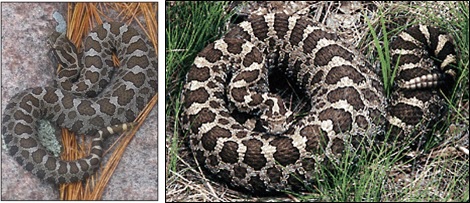
Figure 1. A juvenile (left) and adult (right) Eastern Massasauga Rattlesnake. Note that the juvenile has not yet developed a segmented rattle (Photos courtesy of the West Parry Sound Health Centre, and the Eastern Massasauga Rattlesnake Stewardship Guide).
Wild Animals in Ontario
Throughout Ontario, people and wild animals live side by side.
There are benefits to living near wild animals. Many people enjoy birds that visit their gardens, bats consume millions of mosquitoes, and coyotes eat mice and rats. However, conflicts can arise when humans encroach on wildlife habitat and wild animals behave in ways that damage our property, cost us money, or endanger our health or safety.
For more information about managing and protecting plants, animals, land, water, forests and other ecosystems, visit the Province of Ontario Wildlife and Nature web page.
Coyotes in Urban Areas:
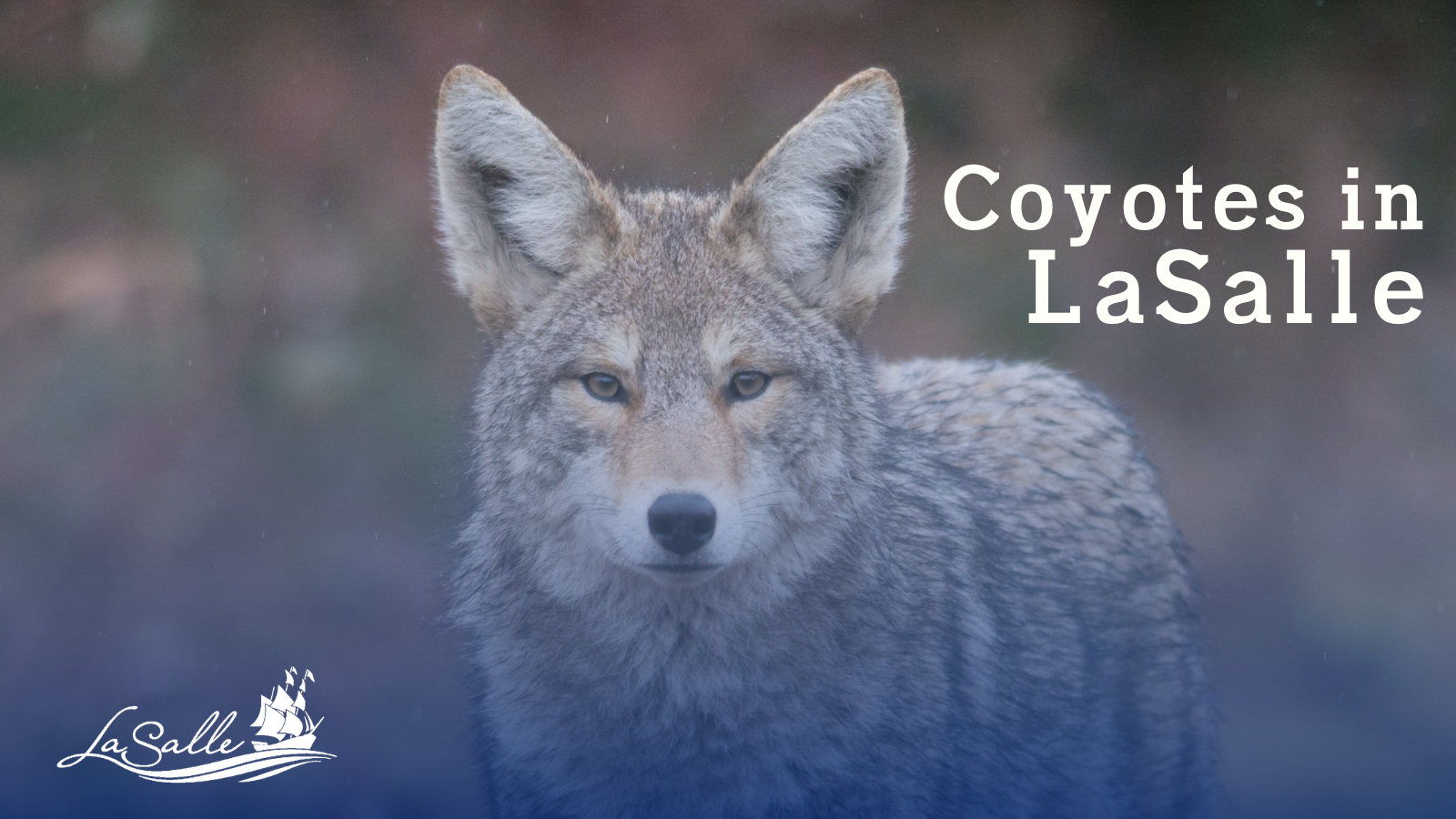
Late January through to early March is mating season for coyotes, so you may hear them howling or yipping to communicate, and you may see more of them.
Coyotes generally do not pose a danger to people, but can pose a danger for pets. For residents who live or walk near typical coyote habitat including creeks, forests ,and open spaces, please take extra caution.
If you see a coyote, keep your distance and the animal will most likely avoid you.
- Never approach, touch, or feed a wild animal
- Keep trash cans covered
- Avoid leaving pets outside unattended
- When walking your dog, keep them on a leash and close by
- Cats should be kept indoors or supervised while outside
- Never run or turn your back on a coyote, slowly back away
If any wild animal poses an immediate threat or danger to public safety, call 9-1-1 or LaSalle Police Service at 519-969-5210. Unless the coyote is posing an imminent threat, please don't call 9-1-1. If you would like to report a coyote sighting, call the LaSalle Police non-emergency line at 519-969-5210.
The Ministry of Natural Resources provides useful information on dealing with coyotes. You can find resources on best practices, encounters with coyotes and protecting your property on their website:
Coyote Watch Canada is a wildlife organization that advocates for positive experiences between humans and wildlife. They offer resources for coexisting with coyotes. Please see Coyote Watch Canada's website for more information:
Report a Coyote Sighting
Coyote Watch Canada tracks the location of coyotes. Share your information about a coyote that you have encountered.
Raccoons
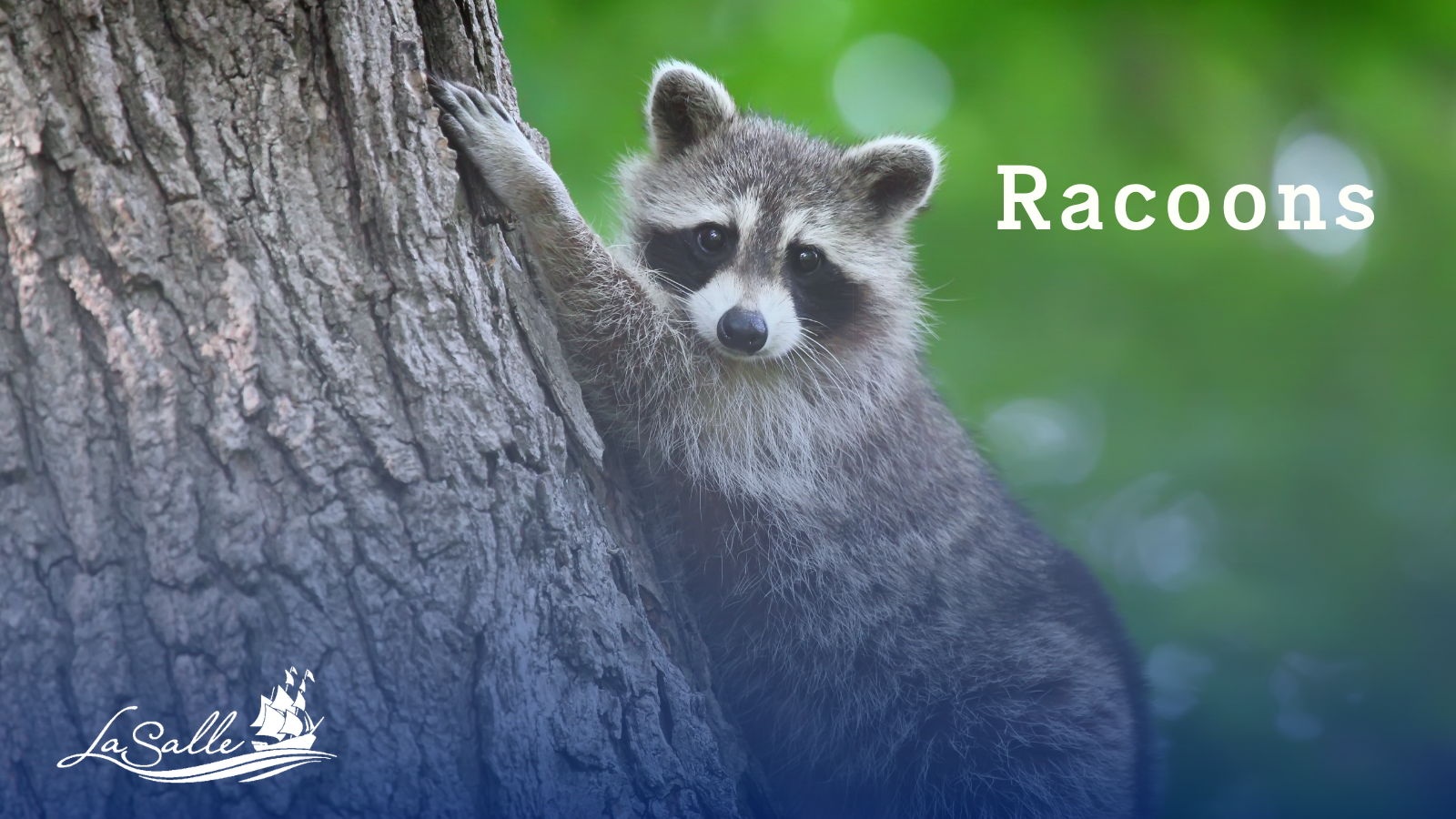
Raccoons are found all over Ontario, in forests, towns, and cities. They are mainly active at night, during the spring, summer, and fall. Raccoons will consume almost any food item, including vegetables, fruits, nuts, plants, eggs, insects, and small creatures. They will also eat from garbage and compost.
Raccoons with Distemper
Raccoons are susceptible to Canine Distemper. This is a virus that may cause the raccoon to act abnormally. Canine distemper is not a risk to humans, but it does pose a threat to dogs that are not vaccinated.
Symptoms of Raccoons with Distemper
- Walking slowly, circling or stumbling as they walk
- Disoriented or lethargic
- Glowing eyes
- Mucus discharge from the eyes and nose
- Coughing, tremors, seizures or chewing fits
- May approach people or curl up to sleep in an open area
- May become aggressive if cornered
What to do if you see a Raccoon that appears to have Distemper
Do not approach the raccoon or attempt to feed them. Call the Ministry of Natural Resources and Forestry at 1-800-667-1940.
The Windsor/Essex County Humane Society may be available to assist locally pending the availability of their officers. You can call 519-966-5751 to report a distempered raccoon.
What to do if you see a dead Raccoon
If you see a dead raccoon in LaSalle (laying on a sidewalk, trail, or on the road) you can call the Town’s Animal Control Officers at 519-816-7627 to report it. This does not include animals on private property. Animals on private property are the responsibility of the property owner. If you are experiencing issues with animals on your property, you should call a licenced trapper for assistance.
Additional things you can do to help
To discourage raccoons or other wildlife from coming onto your property:
- Do not leave any food out in the open
- Ensure that all garbage and recycling is securely stored and only left out when necessary for collection
- Keep your pet on a leash when outside and check the yard before letting them out
- Check with your vet if you are unsure whether your dog is vaccinated or not
Resources
The following documents have been prepared by the Government of Ontario, the Government of Canada, and/or Toronto Zoo and will provide you some additional information about Massasaugas:
Massasauga in Ontario: Ontario Recovery Strategy Series (PDF)
Contact Us
Town of LaSalle
5950 Malden Road
LaSalle, ON N9H 1S4
T. 519-969-7770
F. 519-969-4469
Map this Location
